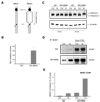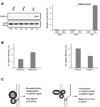Recruitment of fanconi anemia and breast cancer proteins to DNA damage sites is differentially governed by replication
- PMID: 19748364
- PMCID: PMC2758766
- DOI: 10.1016/j.molcel.2009.06.034
Recruitment of fanconi anemia and breast cancer proteins to DNA damage sites is differentially governed by replication
Abstract
Fanconi anemia (FA) is characterized by cellular hypersensitivity to DNA crosslinking agents, but how the Fanconi pathway protects cells from DNA crosslinks and whether FA proteins act directly on crosslinks remain unclear. We developed a chromatin-IP-based strategy termed eChIP and detected association of multiple FA proteins with DNA crosslinks in vivo. Interdependence analyses revealed that crosslink-specific enrichment of various FA proteins is controlled by distinct mechanisms. BRCA-related FA proteins (BRCA2, FANCJ/BACH1, and FANCN/PALB2), but not FA core and I/D2 complexes, require replication for their crosslink association. FANCD2, but not FANCJ and FANCN, requires the FA core complex for its recruitment. FA core complex requires nucleotide excision repair proteins XPA and XPC for its association. Consistent with the distinct recruitment mechanism, recombination-independent crosslink repair was inversely affected in cells deficient of FANC-core versus BRCA-related FA proteins. Thus, FA proteins participate in distinct DNA damage response mechanisms governed by DNA replication status.
Figures




Similar articles
-
FANCD2, FANCJ and BRCA2 cooperate to promote replication fork recovery independently of the Fanconi Anemia core complex.Cell Cycle. 2015;14(3):342-53. doi: 10.4161/15384101.2014.987614. Cell Cycle. 2015. PMID: 25659033 Free PMC article.
-
Crosstalk between BRCA-Fanconi anemia and mismatch repair pathways prevents MSH2-dependent aberrant DNA damage responses.EMBO J. 2014 Aug 1;33(15):1698-712. doi: 10.15252/embj.201387530. Epub 2014 Jun 25. EMBO J. 2014. PMID: 24966277 Free PMC article.
-
FANCJ protein is important for the stability of FANCD2/FANCI proteins and protects them from proteasome and caspase-3 dependent degradation.Oncotarget. 2015 Oct 6;6(30):28816-32. doi: 10.18632/oncotarget.5006. Oncotarget. 2015. PMID: 26336824 Free PMC article.
-
Emergence of a DNA-damage response network consisting of Fanconi anaemia and BRCA proteins.Nat Rev Genet. 2007 Oct;8(10):735-48. doi: 10.1038/nrg2159. Epub 2007 Sep 4. Nat Rev Genet. 2007. PMID: 17768402 Review.
-
Assessing the link between BACH1/FANCJ and MLH1 in DNA crosslink repair.Environ Mol Mutagen. 2010 Jul;51(6):500-7. doi: 10.1002/em.20568. Environ Mol Mutagen. 2010. PMID: 20658644 Review.
Cited by
-
BRCA1 and its toolbox for the maintenance of genome integrity.Nat Rev Mol Cell Biol. 2010 Feb;11(2):138-48. doi: 10.1038/nrm2831. Epub 2009 Dec 23. Nat Rev Mol Cell Biol. 2010. PMID: 20029420 Free PMC article. Review.
-
Human variation databases.Database (Oxford). 2010 Jul 17;2010:baq015. doi: 10.1093/database/baq015. Database (Oxford). 2010. PMID: 20639550 Free PMC article. Review.
-
Imaging cellular responses to antigen tagged DNA damage.DNA Repair (Amst). 2018 Nov;71:183-189. doi: 10.1016/j.dnarep.2018.08.023. Epub 2018 Aug 23. DNA Repair (Amst). 2018. PMID: 30166246 Free PMC article. Review.
-
The BRCA1-interacting protein Abraxas is required for genomic stability and tumor suppression.Cell Rep. 2014 Aug 7;8(3):807-17. doi: 10.1016/j.celrep.2014.06.050. Epub 2014 Jul 24. Cell Rep. 2014. PMID: 25066119 Free PMC article.
-
A Surge of DNA Damage Links Transcriptional Reprogramming and Hematopoietic Deficit in Fanconi Anemia.Mol Cell. 2020 Dec 17;80(6):1013-1024.e6. doi: 10.1016/j.molcel.2020.11.040. Mol Cell. 2020. PMID: 33338401 Free PMC article.
References
-
- Alpi AF, Pace PE, Babu MM, Patel KJ. Mechanistic insight into site-restricted monoubiquitination of FANCD2 by Ube2t, FANCL, and FANCI. Mol Cell. 2008;32:767–777. - PubMed
-
- Ciccia A, Ling C, Coulthard R, Yan Z, Xue Y, Meetei AR, Laghmani el H, Joenje H, McDonald N, de Winter JP, et al. Identification of FAAP24, a Fanconi anemia core complex protein that interacts with FANCM. Mol Cell. 2007;25:331–343. - PubMed
-
- Erkko H, Xia B, Nikkila J, Schleutker J, Syrjakoski K, Mannermaa A, Kallioniemi A, Pylkas K, Karppinen SM, Rapakko K, et al. A recurrent mutation in PALB2 in Finnish cancer families. Nature. 2007;446:316–319. - PubMed
Publication types
MeSH terms
Substances
Grants and funding
- GM44664/GM/NIGMS NIH HHS/United States
- P01 CA097175/CA/NCI NIH HHS/United States
- P01 CA097175-01A20003/CA/NCI NIH HHS/United States
- R01 CA127945-01A2/CA/NCI NIH HHS/United States
- AG000688-07/AG/NIA NIH HHS/United States
- ImNIH/Intramural NIH HHS/United States
- R37 GM044664/GM/NIGMS NIH HHS/United States
- R01 CA138804-01A1/CA/NCI NIH HHS/United States
- R01 CA127945/CA/NCI NIH HHS/United States
- R01 CA091029/CA/NCI NIH HHS/United States
- P01 CA097175-059002/CA/NCI NIH HHS/United States
- P01-CA97175/CA/NCI NIH HHS/United States
- HHMI/Howard Hughes Medical Institute/United States
- R01 CA138804/CA/NCI NIH HHS/United States
- R01 GM044664/GM/NIGMS NIH HHS/United States
- R01 CA091029-04/CA/NCI NIH HHS/United States
LinkOut - more resources
Full Text Sources
Other Literature Sources
Medical
Research Materials
Miscellaneous

